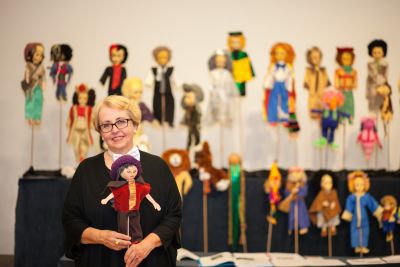Angelika J. Trojnarski – In search of a deeper understanding of the world
Mediathek Sorted













































































The Anthropocene
Through her works, the artist aims to increase awareness of natural phenomena, not only because such events are particularly and unusually beautiful, but because she recognises our responsibility for nature and the natural processes which are now being disturbed by human behaviour. She reminds us of the fragility of our planet and the ecological crisis it faces by highlighting the impact of the Anthropocene in her work. For a long time now, we have attempted to forcibly harness physical forces and processes in our very own destructive dynamic, without turning our attention to the huge extent to which all phenomena and events are interconnected. In so doing, we are wearing down the Earth’s resources and exhausting the planet through our consumption. As a result, we have reached a state in which nature, which has always had its own, unique self-regulatory system, is responding to our actions, sometimes with unexpected vehemence. These reactions testify to the huge complexity of our planet.
In 2000, Eugene Stoermer and Paul Crutzen coined the term “the Anthropocene” to describe the dominant geophysical impact of humankind on the Earth’s system.[1] However, long before they did so, the chemist James Lovelock, in collaboration with the microbiologist Lynn Margulis, had already investigated the multi-layered, convoluted interrelationships between the human and the non-human. They described our planet’s ecosystem as “Gaia”, adopting a term from Greek mythology, where Gaia is the personification of the great Earth mother who was born directly from Chaos and who is the opposite of the ordered cosmos. In the language of the natural sciences today, “Chaos”, which in antiquity was used in reference to the original state of the world, is again being used in an appropriate way to describe the unforeseen nature of processes. According to the Gaia hypothesis of Lovelock and Margulis from the 1970s,[2] Earth is a self-organising system which should be treated as a living organism – and not as a dead storage site for resources from which humans can take what they want as and when they choose. Once the Earth was understood as being a living thing, and began to be studied as such, the realisation took hold that it was a powerful, living aggregate of all organisms, and that the forces of nature in particular were subject to their own internal processes which outdid our human efforts by far. In the words of Lovelock: “[...] if we fail to take care of the Earth, it surely will take care of itself by making us no longer welcome.”[3]
The Pyrocene
Angelika J. Trojnarski succeeds in creating images for the force of nature when we may have become immune to events in the news. She finds an aesthetic expression for the planet’s independent nature, made increasingly palpable and visible in the form of natural disasters, like a sick patient rearing up in an attempt to shake off insatiable parasites from their body.
In recent years, heatwaves have fanned drought on a vast scale, leading to parched soil, dried-up rivers and forests burning across the globe. Such events have become so commonplace that the artist speaks of the Earth’s fever, drawing on the term “Pyrocene”[4], which she uses as a name for a series of collages. Using real fire, with which she burns the edges of her collages and creates traces of soot, her works act as witnesses to a conflagration; they express her way of seeing the world, and are symbol and the symbolised at the same time. Trojnarski’s images testify to the risks and threats to our planet, but they are also of surprising beauty, a poetic aesthetic which unfolds by simply allowing things to emerge and paradoxes to arise. In this way, a cloud can become an infernal image of the sky instead of exuding baroque splendour. Full of dust and soot (Stress, 2019), however, it can also direct the viewer’s gaze to a discrepancy by obtaining its delicate lightness through thorny burrs – small, ornery balls that get their hooks into everything when you get too close, and which at the same time exude a brittle yet delicate elegance (Risk and Wonder, 2022). What would appear to be contradictory in nature is therefore unified in the material. Angelika J. Trojnarski never chooses this material without careful preparation. Her intensive involvement with nature and her research allow her to fully immerse herself in her subject and to search for a deeper understanding of the world through art and science. Her studio in Düsseldorf-Reisholz, which she also uses as a laboratory, contains various objects that she has brought back from her travels: magnetites, self-grown salt crystals, charred plants and pieces of tree bark. All these forms have been created by the forces of nature, like the works that are created here, testaments to a fragile era in the history of the Earth and a reminder of what needs to be preserved.
Ann-Katrin Günzel, April 2024
Website of Angelika J. Trojnarski:
https://trojnarski.com/
[1] Paul J. Crutzen and Eugene F. Stoermer: The “Anthropocene”, in: IGBP Global Change Newsletter, No. 41, May 2000, p. 17–18.
[2] James Lovelock: Gaia. A New Look at Life on Earth, Oxford 1979.
[3] James Lovelock: The Revenge of Gaia. Why the Earth is Fighting Back and How We Can Still Save Humanity. Penguin Books Ltd. 2007, p. 14.
[4] The term was coined by the US environmental historian Stephen J. Pyne in 2015. He wanted to make it clear that we have arrived in a new era in which the power of fire, heated by climate change, will make a decisive mark on our basis of existence. Pyne, Stephen J.: The Pyrocene. How We Created an Age of Fire, and What Happens Next, Oakland (Cal.) 2021.





















































































